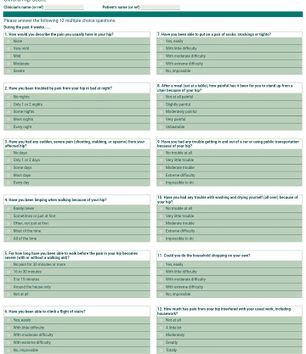Oxford Hip Score
Introduction[edit | edit source]
The Oxford Hip Score (OHS) is a joint-specific, patient-reported outcome measure tool designed to assess disability in patients undergoing total hip replacement (THR)[1]. It was developed in 1996[2] to be simple to administer in order to facilitate use[2], with new scoring introduced in 2007[3].
Objective[edit | edit source]
Its primary goal during development was to assess pain and function in patients undergoing Joint replacement surgery. Apart from it's utility in evaluating THR patients, the OHS is also used to assess patients after alternative non-surgical interventions. This includes physical therapy, joint supplements, and anti-inflammatory medications.
The OHS is used for studies, trials and national registers[4].
Method of Use[edit | edit source]
The OHS is a short 12-item survey that can be done with pen and paper, or online. Patients are asked to reflect on their pain and functional ability over the previous four weeks. There are two domains (pain and function) with six items or questions in each. Each item has five possible responses. In the original scoring[2] responses were from 1 = least difficult to 5= most difficult. Item scores are summed to give a total score from anywhere between 12 and 60. The lower the score, the better the outcome.
In a 2007 update, due to confusion and variability in the clinical setting, the original authors recommended using the following scoring: Responses range from 0 to 4 where 0 represents the worst outcome and 4 represents the best, In this use, 48 is the maximum (and best) score achievable[3]. A guide to the new scoring can be found here. A minimum clinically important difference of 3-5 points has been suggested by not verified[3].
Regardless of which scoring system is used, it should be clearly documented which one is used[3].
Score Interpretation[edit | edit source]
The scores for the 0-48 scale can be interpreted as follows[5]:
Score 0 to 19 May indicate severe hip arthritis. It is highly likely that you may well require some form of surgical intervention, contact your family physician for a consult with an orthopaedic surgeon.
Score 20 to 29 May indicate moderate to severe hip arthritis. See your family physician for an assessment and x-ray. Consider a consult with an orthopaedic surgeon.
Score 30 to 39 May indicate mild to moderate hip arthritis. Consider seeing your family physician for an assessment and possible x-ray. You may benefit from non-surgical treatment, such as exercise, weight loss, and/ or anti-inflammatory medication.
Score 40 to 48 May indicate satisfactory joint function. May not require any formal treatment.
Validity and Reliability[edit | edit source]
One review[4] of the OHS alongside other similar outcome measures noted the OHS has "excellent psychometric properties" although issues to look out for were double-barrelled questions and a lack of questions regarding medication and aids.
Nilsdotter et al[4] reported that the OHS more responsive than both generic measures, such as the Short Form 36 and EuroQol 5‐domain, and the disease‐specific measures the Western Ontario and McMaster Universities Osteoarthritis Index and the Arthritis Impact Measurement Scales.
A review of the validity of this score has shown a strong correlation, practicable, reliable, and valid for self assessment of pain and function in German-speaking patients with hip osteoarthritis[6]. The OHS has also been translated to Dutch[7], Japanese[8] and French[9].
References[edit | edit source]
- ↑ Wylde V, Learmonth ID, Cavendish VJ. The Oxford hip score: the patient’s perspective. Health and quality of life outcomes. 2005 Dec;3(1):66. Accessed 24 June 2019.
- ↑ 2.0 2.1 2.2 Dawson J, Fitzpatrick R, Carr A, Murray D. Questionnaire on the perceptions of patients about total hip replacement. J Bone Joint Surg Br 1996; 78: 185–90. Accessed 24 June 2019.
- ↑ 3.0 3.1 3.2 3.3 Murray DW, Fitzpatrick R, Rogers K,Pandit H, Beard DJ, Carr AJ, et al. The use of the Oxford Hip and Knee Scores. J Bone Joint Surg Br 2007; 89: 1010–4. Accessed 24 June 2019.
- ↑ 4.0 4.1 4.2 Nilsdotter A, Bremander A. Measures of hip function and symptoms: Harris Hip Score (HHS), Hip Disability and Osteoarthritis Outcome Score (HOOS), Oxford Hip Score (OHS), Lequesne Index of Severity for Osteoarthritis of the Hip (LISOH), and American Academy of Orthopedic Surgeons (AAOS) Hip and Knee Questionnaire. Arthritis Care Res. 2011. 63; S11 Supplement: Special Outcomes: S200-S207. Accessed 21 June 2019.
- ↑ MEDICI Medical Practice, 2019. Accessed 24 June 2019. Available from: http://www.medicipractice.co.uk/navigator/oxford-hip-score/
- ↑ Florian D, Marc S, Franco M, Fabian VK, Anne F, Micheal L. Reliability and Validity of the cross-culturally Adapted German Oxford Hip Score. Clin Orthop Relat Res. 2009;467(4):952-957. Accessed 24 June 2019.
- ↑ Gosens T, Hoefnagels NH, de Vet RC,Dhert WJ, van Langelaan EJ, Bulstra SK, et al.The “Oxford Heup Score”: the translation and validation of a questionnaire into Dutch to evaluate the results of total hip arthroplasty. Acta Orthop 2005; 76: 204–11.
- ↑ Uesugi Y, Makimoto K, Fujita K, Nishii T,Sakai T, Sugano N. Validity and responsiveness of the Oxford Hip Score in a prospective study with Japanese total hip arthroplasty patients. J Orthop Sci 2009; 14:35–9.
- ↑ Delaunay C, Epinette JA, Dawson J,Murray D, Jolles BM. Cross‐cultural adaptations of the Oxford‐12 Hip score to the French speaking population. Orthop Traumatol Surg Res 2009; 95: 89–99.







